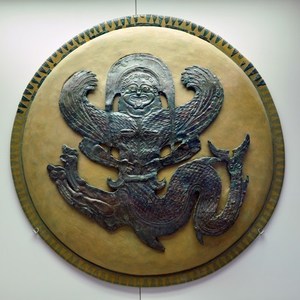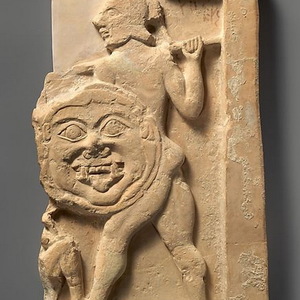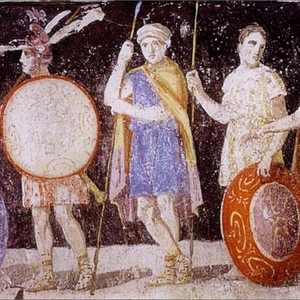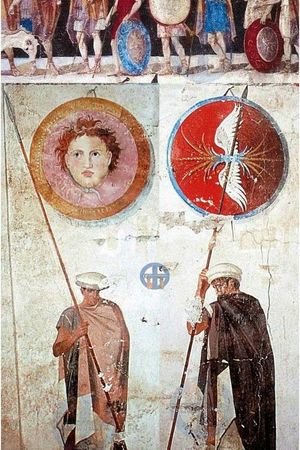Hoplon
Hoplon (other Greek :ππλον), or Argive shield — a round convex shield, which was the main protection of the Greek Hoplites, who got their name from the name of the shield. Despite the fact that this designation was widely used, the historically correct name of the shield is aspis (other Greek: ασπις) or aspida (ΑσπίΔα). The name "hoplon" is mistakenly used in many languages, but the Greeks distinguished between hoplon and aspis. It is assumed that this type of shield appeared in the 8th century BC, as evidenced by the surviving images on ceramics.
The size of the hoplon varied, its diameter was from 80 cm to 1 meter. It provided protection for the Hoplite from the chin to the knees.
The hoplon weighed between 6 to 15 kg. Due to its weight, the shield hindered active offensive maneuvers and prevented the warrior from running. When fleeing, warriors would first discard their shields, and losing a shield was considered a disgrace and severely punished (even up to capital punishment). This did not apply to the loss of a helmet or armor since they served for personal protection, whereas the shield determined the survival of the entire phalanx. Thanks to its round shape and large size, the hoplon not only protected its owner but also their comrades. Fallen warriors were also carried off the battlefield on their shields. This is associated with the origin of the famous phrase attributed to a Spartan woman who, while sending her son off to war, handed him a shield with the words, "With it or on it".
 Hoplite shield from the museum in Olympia. The front surface of the shield is decorated with a bronze embossed overlay with the image of Phobos. 6th century BC
Hoplite shield from the museum in Olympia. The front surface of the shield is decorated with a bronze embossed overlay with the image of Phobos. 6th century BC The core of the hoplon was made of hard wood and consisted of joined planks approximately 0.5 cm thick. The most common construction method involved the wooden core being covered with leather on the inner side and bronze or iron on the outer side. Sometimes, the outer side was also covered with leather (typically from a bull), and only the rim was made of metal. In the center of the inner side, there was a wide bronze grip called porpax, where the hand would reach up to the elbow. With their hand gripping the second handle located at the edge of the shield, called antilabe, the warrior could control the shield. The antilabe was made of a cord or leather strap passed through two bronze loops. Rings were often placed around the perimeter of the shield, through which the cord forming the antilabe would pass. The shield could be slung over the shoulder using this cord, allowing for more comfortable movement during campaigns. The hoplon was sufficiently convex so that the upper edge rested on the warrior's shoulder, making it easier to hold.
Related topics
Hoplite, Shield, Hoplomachus, My Hoplon: reconstruction experience., Ancient Greece
Literature
- Barry John. Wars of antiquity. From the Greco-Persian wars to the fall of Rome / Translated from English by T. Barakina, A. Nikitina, S. Samchenko et al. - Moscow: Eksmo, 2009. - 2nd ed. - 232 p.: ill. - Series "Military history of mankind". — ISBN 978-5-699-30727-2.
- Connolly Peter. Greece and Rome. Encyclopedia of military history / Translated from English by S. Lopukhova, A. S. Khromova. - Moscow: Eksmo-Press, 2000. - 320 p.: ill. — ISBN 5-04-005183-2.
- Lavrenov S. Ya. Armies of Ancient Greece. - Moscow: OOO "AST"; Astrel, 2001. - 48 p.: ill. - "Military-historical series "Soldat"". — ISBN 5-17-004689-8.
- Second Neil. Army of Sparta / Translated from English by A.V. Krasulina. - Moscow: OOO "AST"; Astrel, 2004. - 72 p.: ill. - Series "Elite troops". — ISBN 5-17-023262-4.
- Tkachuk T. M. Ancient weapons and armor: a new age. Types of ancient weapons and methods of making its copies in modern conditions. - Moscow: Donetsk AST; Stalker, 2007. - 250 p.: ill. - ISBN 5-17-029834-X.

 Gallery
Gallery











